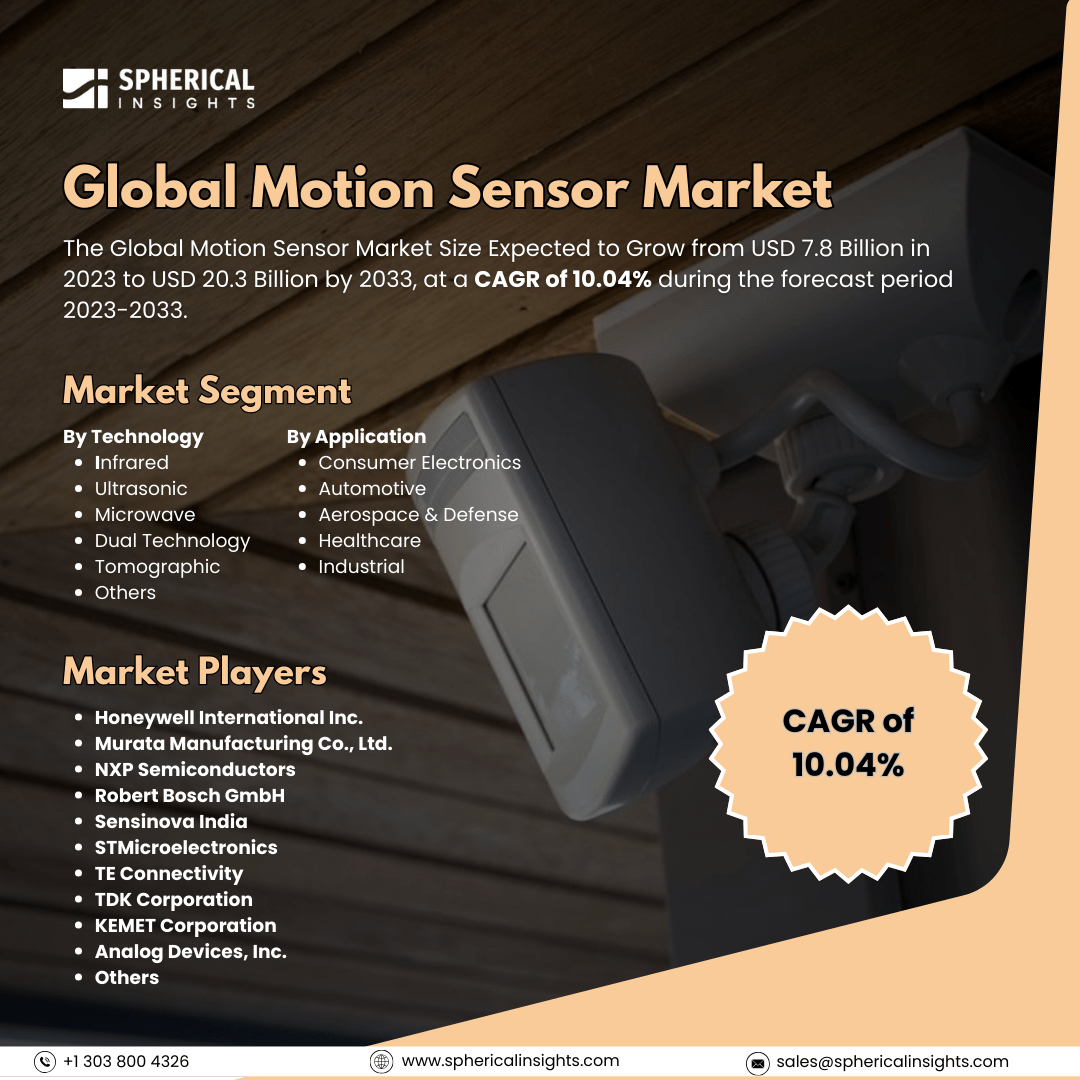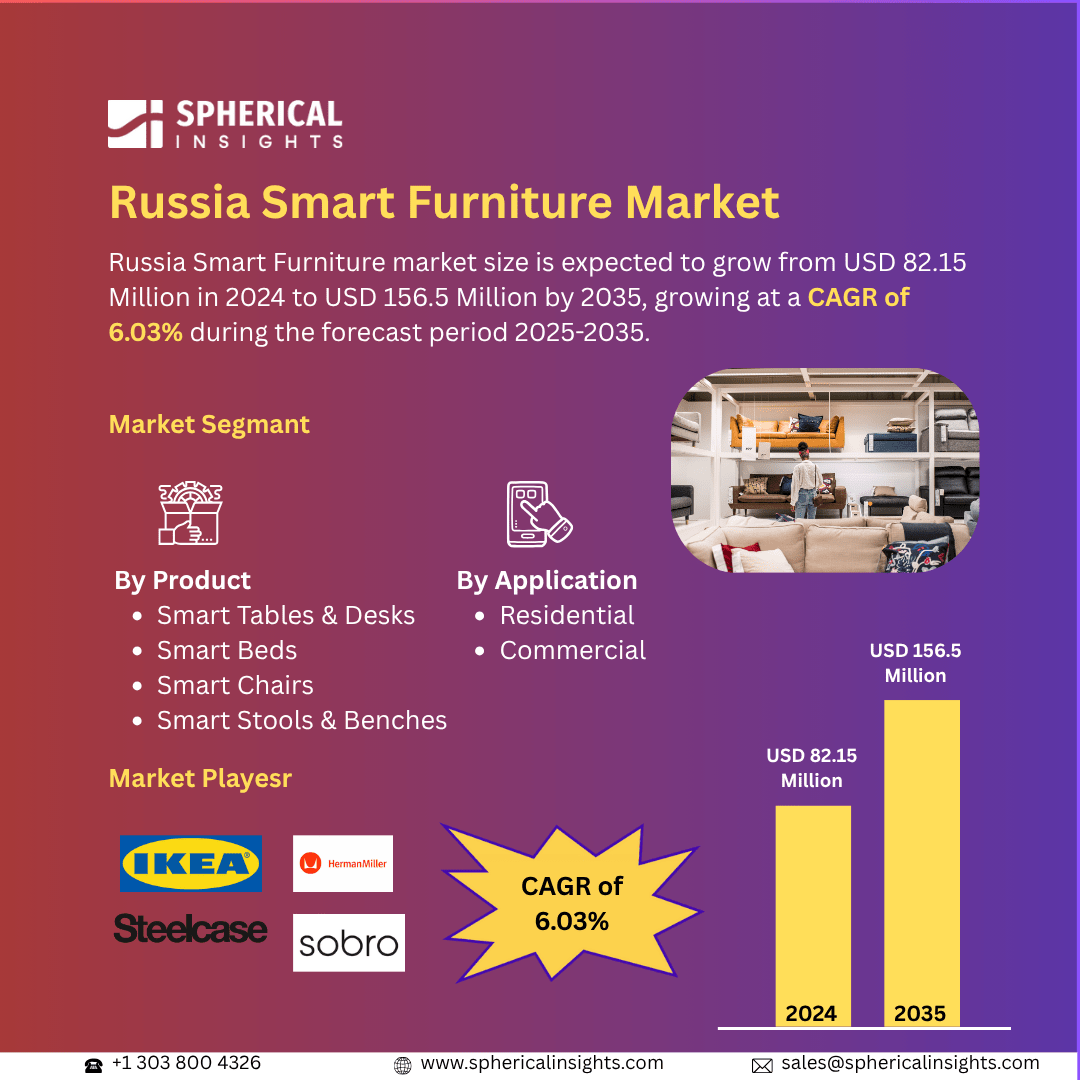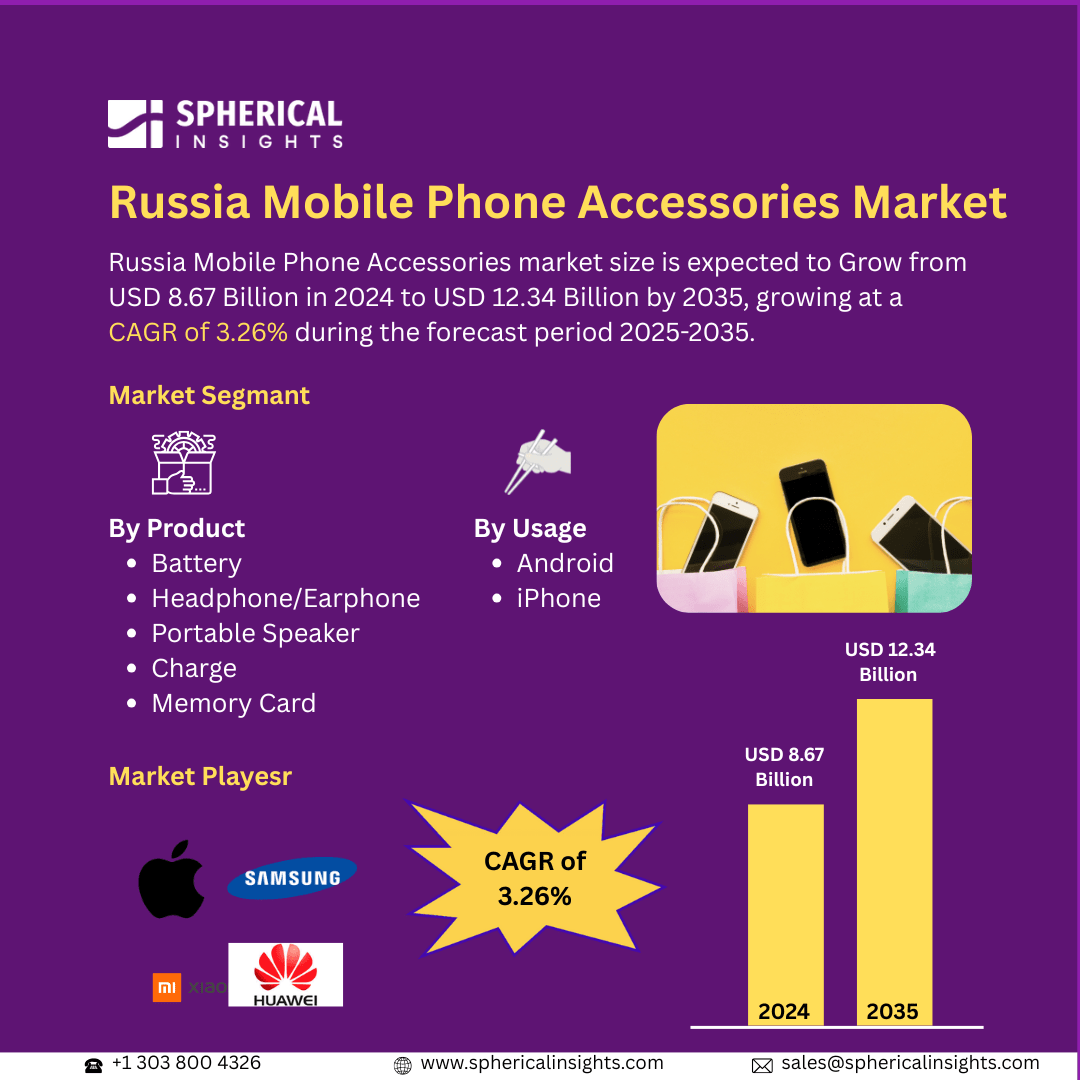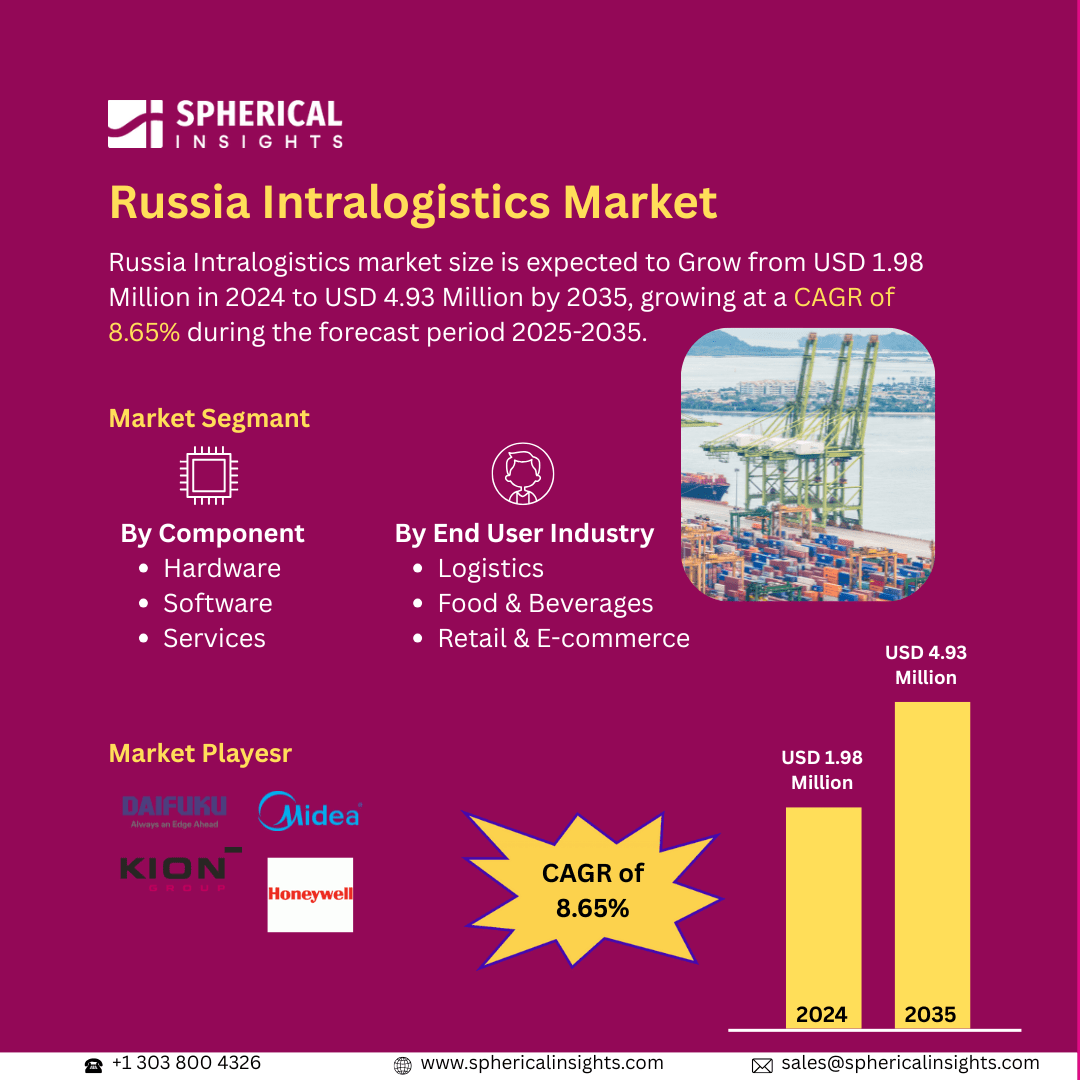Global Motion Sensor Market Size to Exceed USD 20.3 Billion by 2033
According to a research report published by Spherical Insights & Consulting, The Global Motion Sensor Market Size Expected to Grow from USD 7.8 Billion in 2023 to USD 20.3 Billion by 2033, at a CAGR of 10.04% during the forecast period 2023-2033.
Browse 210 market data Tables and 45 Figures spread through 190 Pages and in-depth TOC on the Global Motion Sensor Market Size, Share, and COVID-19 Impact Analysis, By Technology (Infrared, Ultrasonic, Microwave, Dual Technology, Tomographic, Others), By Application (Consumer Electronics, Automotive, Aerospace & Defense, Healthcare, Industrial), and By Region (North America, Europe, Asia Pacific, Latin America, Middle East, and Africa), Analysis and Forecast 2023 – 2033
The global motion sensor market refers to the industry related to the manufacture and implementation of devices that identify and respond to physical movement. These sensors find applications in areas such as security systems, automotive, consumer electronics, healthcare, and industrial automation. Moreover, demand in the global market for motion sensors is growing rapidly due to smart home devices that require motion sensors for security, automation, and energy management. The automotive industry is also driving growth, mainly through safety applications such as collision detection. For instance, improvements in Internet of Things technologies, industrial automation, and wearable devices, coupled with an increasing demand for energy-efficient solutions, have spurred the adoption of motion sensors across multiple industries, thus contributing to the growth of the market. However, the restraints of the motion sensor market would be high installation costs, limited awareness in developing regions, privacy concerns, data security issues, and integration complexities.
The infrared segment accounted for the largest share of the global motion sensor market in 2023 and is anticipated to grow at a significant CAGR during the forecast period.
On the basis of technology, the global motion sensor market is divided into infrared, ultrasonic, microwave, dual technology, tomographic, and others. Among these, the infrared segment accounted for the largest share of the global motion sensor market in 2023 and is anticipated to grow at a significant CAGR during the forecast period. The devices are highly valued for their broad use in security systems, HVAC systems, and smart homes, as they offer energy efficiency at relatively affordable prices, thereby finding more and more usage across several industries.
The consumer electronics segment accounted for a substantial share of the global motion sensor market in 2023 and is anticipated to grow at a rapid pace during the projected period.
On the basis of application, the global motion sensor market is divided into consumer electronics, automotive, aerospace & defense, healthcare, and industrial. Among these, the consumer electronics segment accounted for a substantial share of the global motion sensor market in 2023 and is anticipated to grow at a rapid pace during the projected period. Factors driving market growth include the increasing adoption of motion sensors in devices such as smartphones, wearables, gaming consoles, and smart home products. Such sensors provide enhanced user experiences and energy-efficient functionalities.
North America is projected to hold the largest share of the global motion sensor market over the projected period.
North America is projected to hold the largest share of the global motion sensor market over the projected period. This is due to the increasing trend of high requirements for advanced technologies in consumer electronics, automotive industries, and especially in healthcare departments. The main advantages of these regions are sound infrastructure, the use of smart homes, and very high investments related to IoT or automation, propelling the rising motion sensor demands in various commercial sectors.
Europe is expected to grow at the fastest CAGR growth of the global motion sensor market during the projected period. It is driven by advancements in the automotive, aerospace, and healthcare industries. The region's focus on innovation, coupled with government initiatives promoting smart manufacturing and IoT integration, contributes to the increased demand for motion sensors. Strong manufacturing capabilities and the adoption of energy-efficient technologies further bolster Europe's position in the market.
Company Profiling
Major vendors in the global motion sensor market are Honeywell International Inc., Murata Manufacturing Co., Ltd., NXP Semiconductors, Robert Bosch GmbH, Sensinova India, STMicroelectronics, TE Connectivity, TDK Corporation, KEMET Corporation, Analog Devices, Inc, and Others.
Key Target Audience
- Market Players
- Investors
- End-users
- Government Authorities
- Consulting and Research Firm
- Venture capitalists
- Value-Added Resellers (VARs)
Recent Development
- In April 2024, Aqara introduced the Motion and Light Sensor P2, a new generation of motion sensors based on the Thread protocol and complying with the Matter standard. Natively connected with Matter, it ensures the highest compatibility across most smart home platforms, such as Amazon Alexa, Apple Home, Google Home, and Samsung SmartThings. By using Matter's local networking capabilities, the P2 sensor also offers better responsiveness and reliability for users.
Market Segment
This study forecasts revenue at global, regional, and country levels from 2023 to 2033. Spherical Insights has segmented the global motion sensor market based on the below-mentioned segments:
Global Motion Sensor Market, By Technology
- Infrared
- Ultrasonic
- Microwave
- Dual Technology
- Tomographic
- Others
Global Motion Sensor Market, By Application
- Consumer Electronics
- Automotive
- Aerospace & Defense
- Healthcare
- Industrial
Global Motion Sensor Market, By Regional
- North America
- Europe
- Germany
- UK
- France
- Italy
- Spain
- Russia
- Rest of Europe
- Asia Pacific
- China
- Japan
- India
- South Korea
- Australia
- Rest of Asia Pacific
- South America
- Brazil
- Argentina
- Rest of South America
- Middle East & Africa
- UAE
- Saudi Arabia
- Qatar
- South Africa
- Rest of the Middle East & Africa



